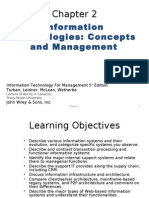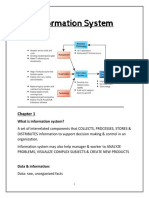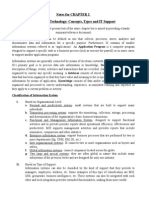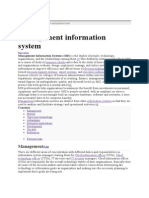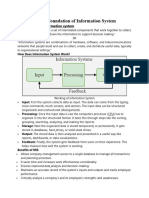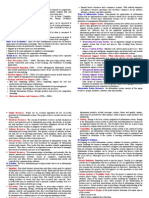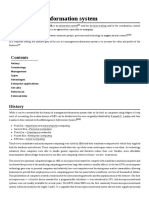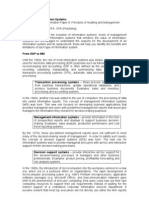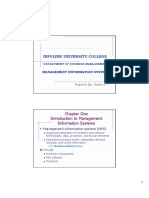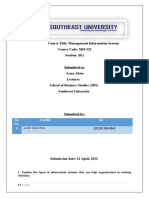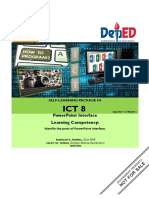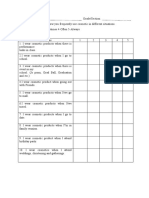Organizations and Information Technology Support
Organizations and Information Technology Support
Uploaded by
Kumpulan DzbCopyright:
Available Formats
Organizations and Information Technology Support
Organizations and Information Technology Support
Uploaded by
Kumpulan DzbOriginal Title
Copyright
Available Formats
Share this document
Did you find this document useful?
Is this content inappropriate?
Copyright:
Available Formats
Organizations and Information Technology Support
Organizations and Information Technology Support
Uploaded by
Kumpulan DzbCopyright:
Available Formats
1
CHAPTER 2
ORGANIZATIONS AND INFORMATION TECHNOLOGY SUPPORT
Learning Objectives
Discuss major information systems concepts such as architecture and infrastructure. Describe the hierarchical structure of organizations and the corresponding information systems. Define various information systems and their evolution, and categorize specific systems. Describe the support provided to different types of employees in an organization. Describe how information resources are managed.
Information Infrastructure
Everything that supports information processing except information itself:
computer hardware general-purpose software networks and communication facilities database information management personnel procedures
Information Architecture
is a general scheme of the information requirements in the organization (including information flows) Information architecture vs. hardware architecture Information architecture vs. concept model of organization
Centralized Information Architecture
(background) Input transactions do not need to be processed in real time; On-line-data-entry personal can be centrally located; Large number of periodic outputs are produced by the system.
Centralized Information Architecture
Single-computer architecture
Mainframe environment; PC environment
Multi-computer architecture
Group of similar computers Group of different computers implementing different tasks.
Decentralized (Distributed) Information Architecture
PC in a LAN or WAN Client/Server
Client/Server in a LAN Enterprisewide computing
Client/Server evolution into Internet-based architecture
Client/Server Architecture
Several computers share resources and are able to communicate with each other
A client - a computer attached to the network, which
is used to request and access shared network resources A server - a machine that is attached to the same network and provides clients with these services
Purpose : optimize the use of computer resources
Enterprisewide Architectures
Access to data, applications, services, and real-time flows of data in different LANs or databases Use client/server architecture to create a cohesive, flexible, and powerful computing environment Provide total integration of departmental and corporate IS resources Increase the availability of information and thereby maximize the value of information
10
Internet-based Architectures
Based on the concepts of client/server architecture and enterprisewide computing The Internet is the basis for a network connection from the outside world to the company, as well as with the organizations web site Organizations internal private Internet (intranet) - useful for distributing information within the organization
11
Organizations : Structure and IT Support
The nature of organizations determines their activities, the information support they need, and the type of information systems they use
profit-making business versus not-for-profit organizations exist manufacture goods versus services are delivered can be located in one place or in several places, some are global or multinational organizations
12
Organizations : Structure
Hierarchical Structure Team-based structure
Project management structure Matrix organizational structure
13
Hierarchical Structure
Headquarters
Division A
Division B
Overseas Division
Plant C Plant D
Administration Services (legal, etc.)
Plant E Plant F
ISD
Accounting
Marketing
Finance
HRM
14
Figure 2.3 Typical matrix organization.
15
Organizations : IT Support
The Corresponding Information Systems
Departmental Information Systems Plant Information Systems Divisional Information Systems Enterprisewide Information Systems Interorganizational Information Systems (IOS) Global Information System for an International or Multinational Corporation
16
Transaction Processing Systems
Organizations perform routine, repetitive tasks a TPS supports the monitoring, collection, storage, processing, and dissemination of the organizations basic business transactions Frequently, several transaction processing systems exist in one company Modern transaction processing systems are much more sophisticated and complex
17
Management Information Systems (MIS)
provide periodic reports generate weekly and monthly summaries by product, customer, or salesperson MIS reports may include summary reports, for the current period or for any number of previous periods - used for monitoring, planning, and control
18
Functional Management Information Systems
geared toward middle managers Access data, organize, summarize, and display information for supporting routine decision making in the functional areas Examples: financial, manufacturing, marketing management, human resources management information systems
19
Major Outputs of a Functional Management Information System
OUTPUT DESCRIPTION
Statistical summaries
Exception reports
Periodic reports
Ad hoc reports Comparative analysis
Projections
Summaries of raw data such as daily production, and weekly and monthly usage of electricity. Highlights of data items that are larger or smaller than designated levels. Statistical summaries and exception reports provided at scheduled, regular periods. Special, unscheduled reports provided on demand. Performance comparison to that of competitors, past performance, or industry standards. Advance estimates of trends in future sales, cash flows, market share, etc.
20
Support Systems
office automation systems (OAS) computer-aided design and manufacturing (CAD/CAM) decision support systems (DSS)
executive information systems (EIS) group support systems (GSS)
Intelligent Systems
Expert systems (ES) Intelligent agents
21
Integrated Systems
various computerized systems are being integrated to increase their functionalities one popular form of integrated system is enterprise resources planning (ERP)
ERP supports planning and management all of an organizations resources and their use, including contacts with business partners
22
The Evolution
Computer Based Information Systems
1940 1950 1960 Scientific, military applications Routine business applications, TPS MIS, office automation DSS, LANs Client/server executive information system, PCs, AI, Groupware
1970 1980
1990 2000
Integration, intelligent systems the Web, intranets, extranets, ERP software Internet, Electronic commerce, Smart systems
23
Clerical Staff
Data workers - use, manipulate, or disseminate information
bookkeepers, secretaries who work with word processors, electronic file clerks, and insurance claim processors
Supported by office automation and groupware, including document management, workflow, email, and other personal productivity software
24
Managers
Implement major functions of organization on almost all levels of an organization
Top managers make strategic decisions Middle managers make tactical decisions Line managers make operational decisions
correspondent Information Systems
Executive Information Systems or DSS Management Information Systems Operation Information Systems
25
Knowledge Workers
Engineers, financial and marketing analysts, production planners, lawyers, and accountants (60-80%): finding or developing new knowledge and integrating it with existing knowledge Advising and consulting the members of the organization introducing new procedures, technologies, or processes Supported by a large variety of information systems from Internet search engines to expert systems, to CAD, and by organizational knowledge bases
26
IT Support at Different Organizational Levels
Strategic Systems
Top Managers Knowledge Workers, Professionals Middle Managers Line Managers, Operators Clerical Staff
Staff Support
Managerial Systems POM Systems
Office Automation and Communication Systems Information Infrastructure and TPS
The information systems support of people in organizations
27
Managing IT Resources
IT resources are scattered throughout the organization Information systems have enormous strategic value Some IT resources change frequently. The responsibility for the management of IT is divided between a usually centralized information systems department (ISD) and the end users
ISD is responsible for corporate-level and shared resources, The end users are responsible for departmental resources
28
Managing Information Technology
Key MIS issues in two recent time periods Key Issues, 1994/1995 Key Issues, 1997 1. Building a responsive IT 1. Improving productivity infrastructure 2. Facilitating and managing 2. Reducing costs business process redesign 3. Developing and managing 3. Improving decision distributed systems making 4. Developing and implementing 4. Enhancing customer an information architecture relationships 5. Planning and managing 5. Developing new communication networks strategic applications
You might also like
- Management Information systems - MIS: Business strategy books, #4From EverandManagement Information systems - MIS: Business strategy books, #4No ratings yet
- Cpms College of Nursing: Assignment ON Electrocardiogram (ECG)Document6 pagesCpms College of Nursing: Assignment ON Electrocardiogram (ECG)Amy Lalringhluani Chhakchhuak100% (3)
- Computer Information SystemsDocument27 pagesComputer Information SystemsnwabisazaddyNo ratings yet
- Information Technologies: Concepts and ManagementDocument41 pagesInformation Technologies: Concepts and ManagementParth PatadiaNo ratings yet
- Unit 1 - Lecture 1Document15 pagesUnit 1 - Lecture 1IMRAN ALAMNo ratings yet
- An Information System Is An Organized Combination of PeopleDocument6 pagesAn Information System Is An Organized Combination of PeopleAshi Garg50% (2)
- Information Technologies Concepts and Management 1224740575843821 8Document39 pagesInformation Technologies Concepts and Management 1224740575843821 8Lucio Dc ParcutelaNo ratings yet
- Assignment On Chapter 2. ISADDocument21 pagesAssignment On Chapter 2. ISAD20220737No ratings yet
- IS Summary ch.1,2,4Document22 pagesIS Summary ch.1,2,401157572404aNo ratings yet
- Chapter 1Document30 pagesChapter 1behailuNo ratings yet
- Information Systems - Basic ConceptsDocument64 pagesInformation Systems - Basic ConceptsSushant SinghNo ratings yet
- Mlo5s Is Elmnhg KoloDocument30 pagesMlo5s Is Elmnhg KoloRafeek makramNo ratings yet
- 2 Ka 3Document32 pages2 Ka 3chahalrajwinder37No ratings yet
- Untitled DocumentDocument8 pagesUntitled Documentasmaa01961No ratings yet
- Chapter # 1: Foundations of Information Systems in BusinessDocument25 pagesChapter # 1: Foundations of Information Systems in Businessdua tanveerNo ratings yet
- Commerce 2ka3: Final ExamDocument53 pagesCommerce 2ka3: Final ExamKristelleNo ratings yet
- CSC 371 Lecture NoteDocument68 pagesCSC 371 Lecture NoteCharlesNo ratings yet
- 4 CbisDocument29 pages4 CbisSheikh ObaidNo ratings yet
- Introduction to Information SystemsDocument80 pagesIntroduction to Information SystemsAmlyan MukherjeeNo ratings yet
- Management Information System CHAPTER 2Document3 pagesManagement Information System CHAPTER 2gut78No ratings yet
- MBA Anna University-Management Information System 2 MarksDocument24 pagesMBA Anna University-Management Information System 2 Markspadma_abivarshini92% (12)
- Management Information System - Wikipedia, The Free EncyclopediaDocument5 pagesManagement Information System - Wikipedia, The Free EncyclopediaSandeep Yadav100% (2)
- 5 - Information System Primary PurposeDocument41 pages5 - Information System Primary Purposecyka blyatNo ratings yet
- Introduction (Chapter 1)Document34 pagesIntroduction (Chapter 1)Ayisha ManzoorNo ratings yet
- Components of Information SystemsDocument57 pagesComponents of Information SystemsG JeevaNo ratings yet
- Management Information SystemDocument4 pagesManagement Information SystemPratiksha Baid DagaNo ratings yet
- Introduction To Information SystemDocument4 pagesIntroduction To Information SystemNiroj ThapaNo ratings yet
- Unit 2 - Overview of Information SystemsDocument7 pagesUnit 2 - Overview of Information SystemsJason Jay MillerNo ratings yet
- Chapter 1Document28 pagesChapter 1SushilchaudharyNo ratings yet
- Operations Support System:: System Performance & Standards: System Performance Can Be Measured inDocument12 pagesOperations Support System:: System Performance & Standards: System Performance Can Be Measured inanshumankhaNo ratings yet
- Management Information SystemDocument56 pagesManagement Information SystemSunil SharmaNo ratings yet
- Management Information SystemDocument5 pagesManagement Information SystemAshwini Kumar JoshiNo ratings yet
- Mis I MbaDocument18 pagesMis I MbaPolice stationNo ratings yet
- Mis EvolutionDocument4 pagesMis EvolutionsenthilrajanesecNo ratings yet
- Lecture Notes - Management Information SystemDocument35 pagesLecture Notes - Management Information SystemDennis MdoeNo ratings yet
- Management Information SystemDocument6 pagesManagement Information SystemSaurabhMoharir0% (1)
- Screenshot 2023-07-24 at 4.50.54 PMDocument53 pagesScreenshot 2023-07-24 at 4.50.54 PMEliyas RahmetoNo ratings yet
- Mis & Erp Module - 1Document21 pagesMis & Erp Module - 1papu222No ratings yet
- Computer ScienceDocument27 pagesComputer Scienceanurag_garg_20No ratings yet
- Management Information System MISDocument6 pagesManagement Information System MISAmandla XokiNo ratings yet
- Inf. Sys. Lec-1Document20 pagesInf. Sys. Lec-1Sagar BhattacharyaNo ratings yet
- 302 MIS & E-Commerce Complete NotesDocument111 pages302 MIS & E-Commerce Complete NotesMohan pachpandeNo ratings yet
- Chapter 2 - Types of Information SystemsDocument10 pagesChapter 2 - Types of Information SystemsNgong ConstantineNo ratings yet
- Whole Notes Combine Canvas PDFDocument17 pagesWhole Notes Combine Canvas PDFKhevana PurohitNo ratings yet
- Meaning and Nature of Information SystemDocument6 pagesMeaning and Nature of Information SystemAdejo WadaNo ratings yet
- MisDocument32 pagesMisGeethika K MararNo ratings yet
- UNIT 1-1Document30 pagesUNIT 1-122bbavigramNo ratings yet
- Management Information System (MIS 501) : Week 03Document38 pagesManagement Information System (MIS 501) : Week 03Junayed AzizNo ratings yet
- Mis Chap 1 NotesDocument5 pagesMis Chap 1 NotesShaheryar RashidNo ratings yet
- 01 - Introduction To Information SystemsDocument58 pages01 - Introduction To Information SystemsTrina Mae OcampoNo ratings yet
- Management Information SystemDocument5 pagesManagement Information Systemolivia523No ratings yet
- What Are The Types of Information System ApaDocument16 pagesWhat Are The Types of Information System ApaAbeer AlshebamiNo ratings yet
- Information and Knowledge SystemsDocument5 pagesInformation and Knowledge SystemsKeerthana RameshNo ratings yet
- Advanced Networking NewDocument414 pagesAdvanced Networking NewKasahun AdissNo ratings yet
- demke 3Document20 pagesdemke 3yonassetegn016No ratings yet
- Please Read: A Personal Appeal From Wikipedia Programmer Brandon HarrisDocument9 pagesPlease Read: A Personal Appeal From Wikipedia Programmer Brandon HarrisAnushree BhatNo ratings yet
- Information Systems Definition: Organization PeopleDocument49 pagesInformation Systems Definition: Organization PeopleTharidu JayarathnaNo ratings yet
- Mid Term Exam MisDocument5 pagesMid Term Exam MisMahamodul Hasan ShohanNo ratings yet
- 2ND Week Lecture Mis 1Document7 pages2ND Week Lecture Mis 1AIZEL JOY POTOTNo ratings yet
- demke 3Document20 pagesdemke 3yonassetegn016No ratings yet
- Zero To Mastery In Cybersecurity- Become Zero To Hero In Cybersecurity, This Cybersecurity Book Covers A-Z Cybersecurity Concepts, 2022 Latest EditionFrom EverandZero To Mastery In Cybersecurity- Become Zero To Hero In Cybersecurity, This Cybersecurity Book Covers A-Z Cybersecurity Concepts, 2022 Latest EditionNo ratings yet
- Tax Incentives Pioneer Status, ITA, Infrastructure AllowanceDocument6 pagesTax Incentives Pioneer Status, ITA, Infrastructure AllowanceKumpulan DzbNo ratings yet
- Bali'S Dream Trip RM USD IDR Transport Flight (Return)Document1 pageBali'S Dream Trip RM USD IDR Transport Flight (Return)Kumpulan DzbNo ratings yet
- 510Document16 pages510Kumpulan DzbNo ratings yet
- Ita - IrbDocument2 pagesIta - IrbKumpulan DzbNo ratings yet
- 013255271X PPT 07Document20 pages013255271X PPT 07Kumpulan DzbNo ratings yet
- Application Form Premis Pan ClassificationDocument5 pagesApplication Form Premis Pan ClassificationKumpulan DzbNo ratings yet
- Bonn & Gaston 2005 Richness Ecosystem Conserv SAfDocument18 pagesBonn & Gaston 2005 Richness Ecosystem Conserv SAfKellyta RodriguezNo ratings yet
- Mar 2019 Paper 2A Questions EngDocument10 pagesMar 2019 Paper 2A Questions EngTerry MaNo ratings yet
- Mental HealthDocument5 pagesMental HealthAmina ĆosićNo ratings yet
- Modeling Effects On Forces in Shear Wall-Frame Structures: Adang SurahmanDocument9 pagesModeling Effects On Forces in Shear Wall-Frame Structures: Adang SurahmanTrio HardiyantoNo ratings yet
- 1-Application Form-Le-One Tab.500mgDocument10 pages1-Application Form-Le-One Tab.500mgMohammed ZubairNo ratings yet
- Analysis For Fault Detection of Vector-Controlled Permanent Magnet Synchronous Motor With Permanent Magnet DefectDocument4 pagesAnalysis For Fault Detection of Vector-Controlled Permanent Magnet Synchronous Motor With Permanent Magnet DefectkkarthiksNo ratings yet
- ĐỀ ĐỀ XUẤT DHBB ANH 10Document17 pagesĐỀ ĐỀ XUẤT DHBB ANH 10jamNo ratings yet
- Morelos Escuelas en Operacion Al 3 de NoviembreDocument138 pagesMorelos Escuelas en Operacion Al 3 de NoviembreEris MiNo ratings yet
- OUC DC 911 Reform Status ReportDocument44 pagesOUC DC 911 Reform Status ReportABC7 WJLANo ratings yet
- DD HipotiroidDocument2 pagesDD Hipotiroidmitra khairaniNo ratings yet
- A CompanyDocument11 pagesA CompanySed ReyesNo ratings yet
- BRANCHES OF AGRICULTURE Day 3Document9 pagesBRANCHES OF AGRICULTURE Day 3abulenciajoven6No ratings yet
- Yhdc SCTDocument3 pagesYhdc SCTDavid S. CastNo ratings yet
- Enemigo Comun InternoDocument44 pagesEnemigo Comun InternoCarlosNo ratings yet
- 625-Article Text-1254-1-10-20221104Document9 pages625-Article Text-1254-1-10-20221104VemascnNo ratings yet
- Tiger. Quentin Trollip PDFDocument22 pagesTiger. Quentin Trollip PDFrodrigo barraza100% (2)
- Entrep ReviewerDocument6 pagesEntrep ReviewerAudrey IyayaNo ratings yet
- Powerpoint Interface Learning Competency:: Self-Learning Package inDocument6 pagesPowerpoint Interface Learning Competency:: Self-Learning Package inanderson villalunaNo ratings yet
- Practical FileDocument70 pagesPractical FileArnav KumarNo ratings yet
- Article 2Document10 pagesArticle 2Linh PhạmNo ratings yet
- Supplier Invoice Template Free Word FormatDocument2 pagesSupplier Invoice Template Free Word Formatarqamahsan707No ratings yet
- Literacy Planning Sheet Year Group: Reception Stimulus: Jolly Phonics Day Skill Learning Objective Main Teaching Focused Task(s) Key Skill 1Document2 pagesLiteracy Planning Sheet Year Group: Reception Stimulus: Jolly Phonics Day Skill Learning Objective Main Teaching Focused Task(s) Key Skill 1Engy HassanNo ratings yet
- Mark Check On How You Frequently Use Cosmetic in Different SituationsDocument3 pagesMark Check On How You Frequently Use Cosmetic in Different Situationsjames alfon villocinoNo ratings yet
- Junior High School Psychosocial ActivitiesDocument29 pagesJunior High School Psychosocial ActivitiesEmeldaNo ratings yet
- đề tiếng anh 6Document44 pagesđề tiếng anh 6imjin0412No ratings yet
- Education OnexxxxDocument3 pagesEducation OnexxxxwickedbootlegNo ratings yet
- RTE RulesDocument22 pagesRTE RulessanjibkNo ratings yet
- ETHICS - Cyber EthicsDocument18 pagesETHICS - Cyber EthicsMoeenuddin Hashim100% (1)
- Automatic Lube Oil Boll FilterDocument26 pagesAutomatic Lube Oil Boll FilterYIOUGO WNo ratings yet



